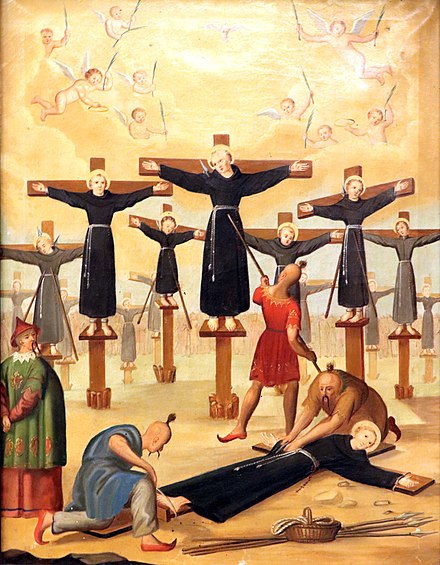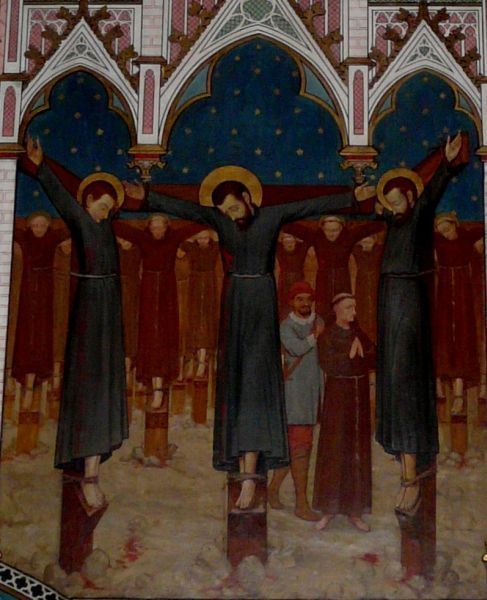Saints Paul Miki, John de Goto & James Kasai, SJ
St Paul Miki, SJ
(1564~1597)
St James Kisai, SJ
(1533~1597)
St John de Goto, SJ
(1578~1597)
 Christianity experienced rapid growth during the forty-one years after St Francis Xavier’s coming to Japan. By 1590, there were about 200,000 Christians in Japan, most of whom lived in either central Japan or on the southern island of Kyushu. This was because several influential political leaders had become converts and because the Emperor, Hideyoshi was favourably disposed to Christianity, the Jesuit mission flourished. However Hideyoshi’s attitude changed because of the fear that the introduction of Christianity was the first in Spain’s effort to conquer Japan, just as they had already conquered Philippines and in 1587, he decreed that all foreign missionaries must leave Japan. This edict was not rigidly implemented and the Jesuits were able to continue their work under threat of persecution. However remarks made in 1596 by the captain of a shipwrecked Spanish ship led Hideyoshi to order the arrest of all Franciscans and along with the Franciscans, police arrested the Jesuits Paul Miki, a scholastic, James Kisai, a brother, and John de Goto, a catechist who was in the process of entering the Society.
Christianity experienced rapid growth during the forty-one years after St Francis Xavier’s coming to Japan. By 1590, there were about 200,000 Christians in Japan, most of whom lived in either central Japan or on the southern island of Kyushu. This was because several influential political leaders had become converts and because the Emperor, Hideyoshi was favourably disposed to Christianity, the Jesuit mission flourished. However Hideyoshi’s attitude changed because of the fear that the introduction of Christianity was the first in Spain’s effort to conquer Japan, just as they had already conquered Philippines and in 1587, he decreed that all foreign missionaries must leave Japan. This edict was not rigidly implemented and the Jesuits were able to continue their work under threat of persecution. However remarks made in 1596 by the captain of a shipwrecked Spanish ship led Hideyoshi to order the arrest of all Franciscans and along with the Franciscans, police arrested the Jesuits Paul Miki, a scholastic, James Kisai, a brother, and John de Goto, a catechist who was in the process of entering the Society.
![]() Paul Miki was born of affluent parents near Osaka and his family became Christians when he was four years old. He joined the Jesuit-run seminary in Azuchi at twenty and two years later entered the Society. He was successful in converting many Buddhists to the faith by his eloquence and was only a few months away from being ordained at the time of his arrest.
Paul Miki was born of affluent parents near Osaka and his family became Christians when he was four years old. He joined the Jesuit-run seminary in Azuchi at twenty and two years later entered the Society. He was successful in converting many Buddhists to the faith by his eloquence and was only a few months away from being ordained at the time of his arrest.
John de Goto was born on one of the islands of the Goto archipela was born on one of the islands of the Goto archipelago of Christian parents but moved to Nagasaki where they have freedom to practice his faith. He was living in the Jesuit community in Osaka and worked as a catechist while planning to join the Society at the time of his arrest .
James Kisaiwas born in the village of Haga, near Okayama of pagan family. He received his early education from a Buddhist bonze but was later baptized He married a Christian convert who bore him a son. He separated from his wife after he failed to talk her out of returning to her former Buddhist beliefs and had to entrust his son to a Christian family to ensure he received a Christian upbringing. He found employment with the Jesuits in Osaka where he took on the job as house porter and later as a catechist when the Jesuits saw how well he knew his faith. He was probably a brother when he was arrested by the police.
Paul Miki, John de Goto and James Kisai were placed under house arrest from December 9 1596 until January 1, 1597 when they were taken to Miyako (today’s Kyoto) and imprisoned with six Franciscans and their fifteen tertiaries. The twenty-four prisoners were taken into the public square and condemned to be executed by crucifixion… As a mark of shame, the left ear lobe of each man was cut off and they were made to do a month-long walk to Nagasaki where they would be executed. Along the way, people insulted and mocked them but Miki and a Franciscan priest preached to the crowd anyway. Just before they reached Nagasaki, two Jesuit priests were able to minister to the prisoners. One of them, Fr Pasio, took the three Jesuits into a chapel where Paul Miki renewed his vows and John de Goto and James Kisai pronounced their first vows.
 That same morning the prisoners were taken to a hill later called “Martyrs’ Hill”, outside the city where they saw crosses lying on the ground waiting for them. They sang a Te Deum, the traditonal song of thanksgiving, when they saw how they were to die. Looking forward to union with God, they rushed to their crosses, embraced them, and placed themselves upon them and waited for their executioners to fasten their bodies with ropes. As the crosses were lifted into the holes, John de Goto saw his father in the crowd and spoke to him: “Father, remember the soul’s salvation is to be preferred to everything else.” The father replied: “My son, I thank you for your words of exhortation. Face death with joy because you are undergoing it for our holy faith. Your mother and I are also ready to die for the same cause.”
That same morning the prisoners were taken to a hill later called “Martyrs’ Hill”, outside the city where they saw crosses lying on the ground waiting for them. They sang a Te Deum, the traditonal song of thanksgiving, when they saw how they were to die. Looking forward to union with God, they rushed to their crosses, embraced them, and placed themselves upon them and waited for their executioners to fasten their bodies with ropes. As the crosses were lifted into the holes, John de Goto saw his father in the crowd and spoke to him: “Father, remember the soul’s salvation is to be preferred to everything else.” The father replied: “My son, I thank you for your words of exhortation. Face death with joy because you are undergoing it for our holy faith. Your mother and I are also ready to die for the same cause.”
Paul Miki also found strength while hanging on the cross to speak to the crowd and his last sermon was to invite the onlookers to embrace Christianity for which he was glad to offer his life. He ended by forgiving his executioner and just as the executioner transfixed him, he said: “into your hand, O Lord, I commend my spirit.”
At thirty-three, Paul Miki was the first Japanese religious to be martyred in Japan. John de Goto was only nineteen and James Kisai sixty-four. They were beatified by Pope Urban VIII on September 14 and 15, 1627 and canonized by Pope Pius IX on June 8, 1862.
